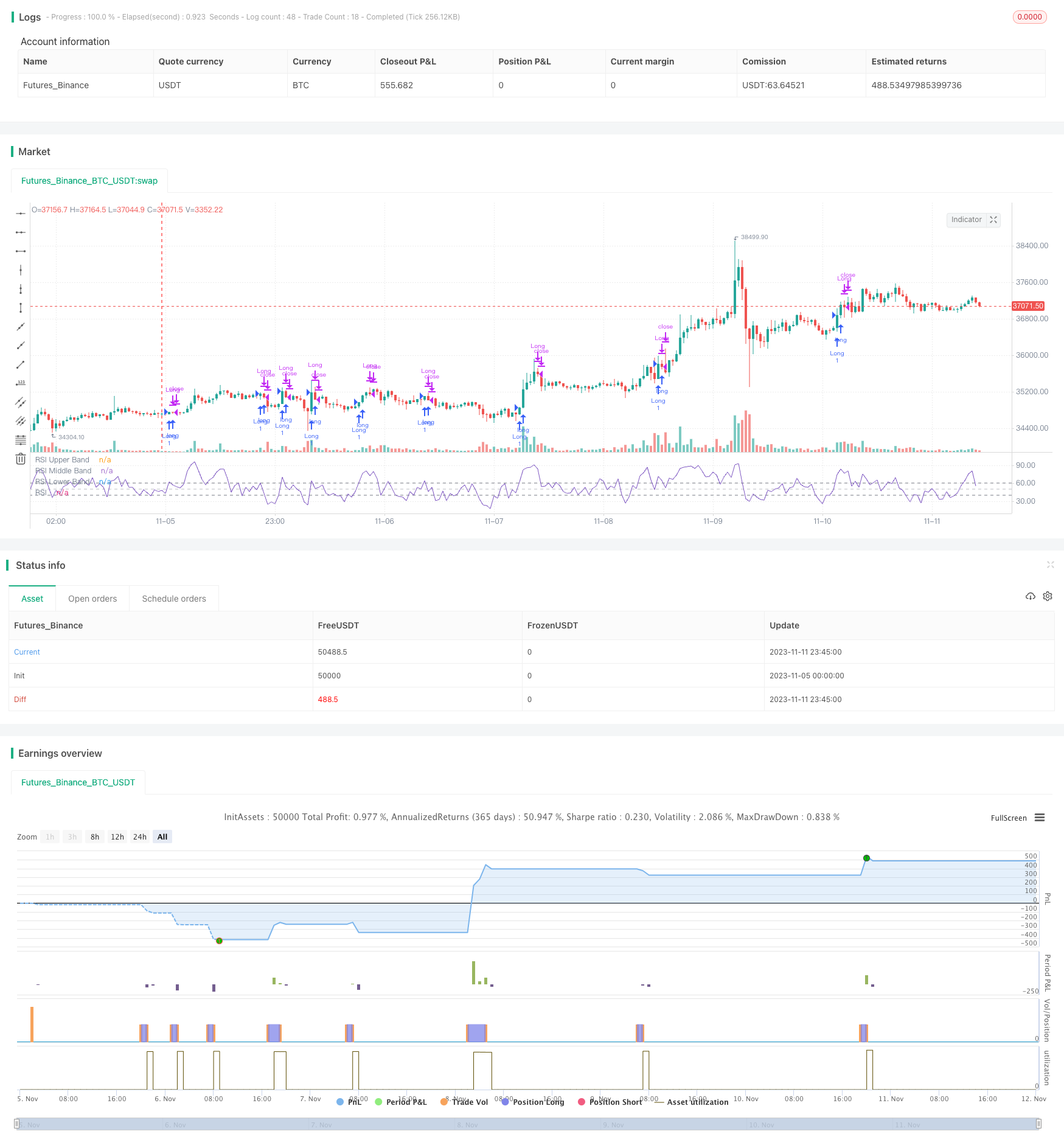
概述
RSI回调突破策略是一种基于相对强弱指标(RSI)的短线交易策略。该策略利用RSI指标识别过卖超跌机会,在股价超跌回调时,寻找RSI指标由低位向上突破进场的机会,通过捕捉股价短线反弹获得盈利。
策略原理
该策略基于RSI指标来判断买入时机。具体逻辑是:
使用length=5的RSI指标,当RSI由低位向上突破60时视为买入信号。
RSI突破60代表股票短期内超跌比较严重,表现为弱势股,此时RSI上穿60有望代表股价产生反弹。
在RSI突破60时开仓做多,采用市价单全仓买入。
当RSI再次下破其前一周期值时视为退出信号,即RSI < RSI[1],发出平仓指令。
该策略主要依靠RSI指标识别短线超跌回调机会,通过捕捉反弹获得盈利。当股价连续下跌导致RSI进入超卖区时,通过RSI指标的回调突破来判断反弹的时机。
优势分析
该策略具有以下优势:
策略思路简单清晰,容易理解实现,适合新手学习;
利用的是成熟指标RSI,有一定的实用性;
采用RSI回调突破判断买点,可以 filtrate 出某些超跌反弹机会;
策略操作频率较高,适合短线交易,可以捕捉短期价格剧烈波动;
策略风险可控,采用止损方式来控制亏损。
风险分析
该策略也存在一些风险:
RSI指标存在一定程度的滞后性,可能导致买入点出现偏差;
股价反弹不一定持续,存在回调再次跌破止损点的可能;
交易频率较高,交易成本可能会比较高;
策略参数需要不断优化,如RSI长度、买入条件等;
多空判断依据单一,当市场持续上行时,策略可能会产生过多错误信号。
优化方向
该策略还可以从以下几个方向进行优化:
结合趋势指标过滤,避免在震荡行情中被套。
加入机器学习模型进行多因子预测,提高买入精确度。
优化止损策略,通过移动止损来锁定更多利润。
适当调整持仓时间,区分长线和短线持仓。
增加波动率过滤,只在大幅波动时才考虑买入。
总结
本策略整体来说较为简单直接,通过RSI指标的回调突破来判断买入时机。策略具有一定实用性,可用于发现短线超跌反弹机会。但RSI指标本身存在滞后性,多空判断单一等问题。后续可通过多因子预测、止损优化、趋势过滤等方式提升策略效果。
/*backtest
start: 2023-11-05 00:00:00
end: 2023-11-12 00:00:00
period: 45m
basePeriod: 5m
exchanges: [{"eid":"Futures_Binance","currency":"BTC_USDT"}]
*/
//@version=5
strategy("*RSI 5 - Long only- Daily charts & above*", overlay = false)
// Define inputs
rsi_length = input(5, "RSI Length")
// Calculate indicators
rsi = ta.rsi(close, rsi_length)
// Entry conditions
long = rsi[1] < 50 and rsi > 60
// Exit conditions
longExit = rsi < rsi[1]
// Execute trade with adjusted position size
if (long)
strategy.entry("Long", strategy.long)
if (longExit)
strategy.close("LongExit")
// Close long position if long exit condition is met
if (longExit)
strategy.close("Long", comment="Long exit")
rsiPlot = plot(rsi, "RSI", color=#7E57C2)
rsiUpperBand = hline(60, "RSI Upper Band", color=#787B86)
midline = hline(50, "RSI Middle Band", color=color.new(#787B86, 50))
rsiLowerBand = hline(40, "RSI Lower Band", color=#787B86)
fill(rsiUpperBand, rsiLowerBand, color=color.rgb(126, 87, 194, 90), title="RSI Background Fill")